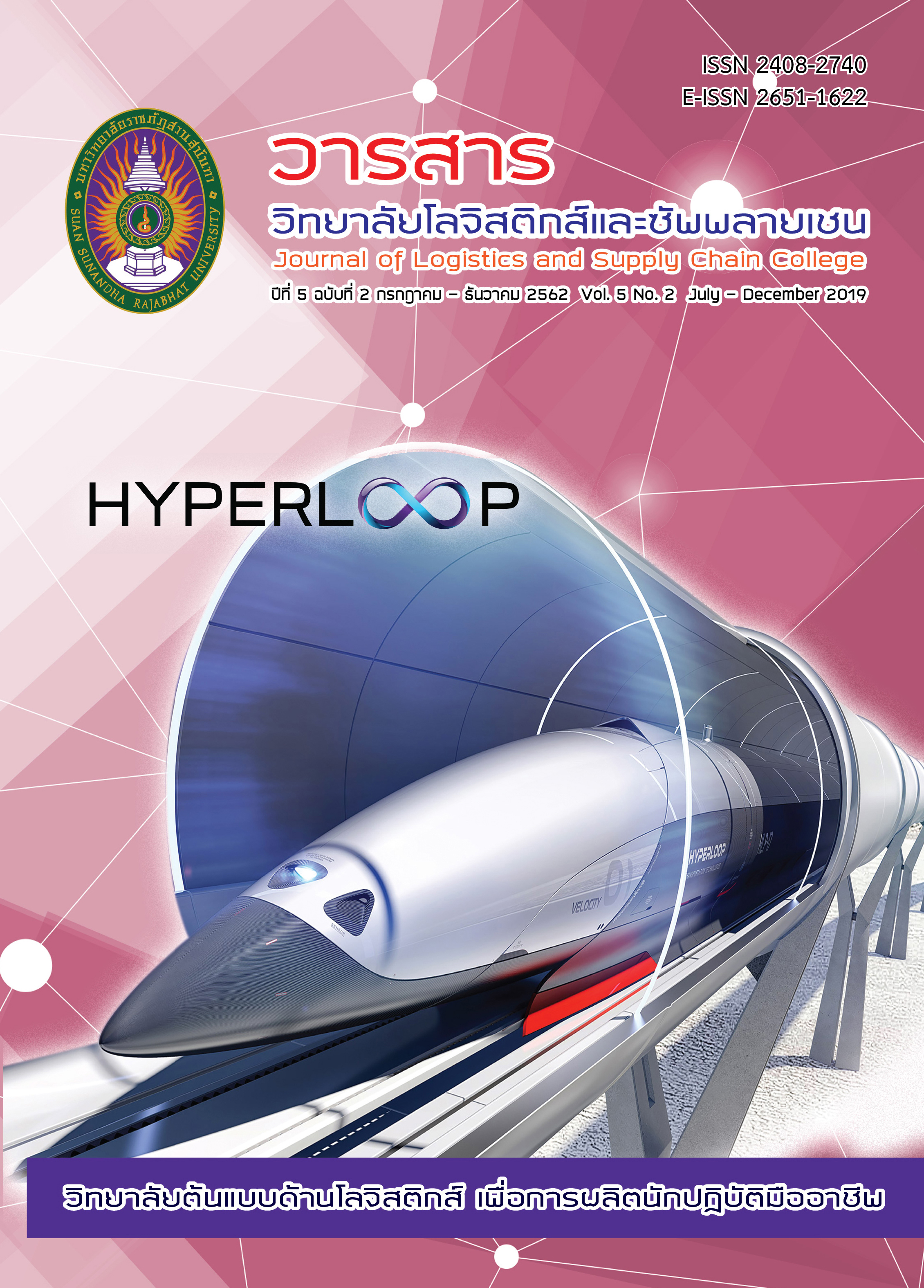การประเมินผลระบบการผลิตแบบลีนโลจิสติกส์มาใช้ในองค์กร : โรงงานอุตสาหกรรมแป้งและน้ำตาล จังหวัดนครราชสีมา
บทคัดย่อ
การวิจัย มีวัตถุประสงค์เพื่อศึกษาการนำระบบการผลิตแบบลีนโลจิสติกส์ (Lean Logistics) มาใช้ในระดับบริบท (context) ปัจจัยนำเข้า (Input) กระบวนการ (process) ผลกระทบ (impact) และข้อเสนอแนะของการนำระบบการผลิตแบบลีนโลจิสติกส์มาใช้ให้ประสบความสำเร็จ วิธีการศึกษาใช้การวิจัยเชิงผสมผสาน (Mixed Method) ระหว่าง วิธีการวิจัยเชิงปริมาณและเชิงคุณภาพ สำหรับการวิจัยเชิงปริมาณ กลุ่มตัวอย่างที่แจกแบบสอบถาม คือ ผู้บริหาร ผู้จัดการและหัวหน้างานที่องค์กรได้นำระบบการผลิตแบบลีนโลจิสติกส์มาใช้ในองค์กร (Key informant) จำนวน 50 ราย ส่วนการวิจัยเชิงคุณภาพจะใช้การสัมภาษณ์แบบเจาะลึกจาก ผู้ให้ข้อมูลที่เกี่ยวข้อง ผลการวิจัย พบว่า 1) การประเมินด้านบริบทของนโยบายพบว่าผู้ตอบแบบสอบถามส่วนใหญ่รับรู้ถึงวัตถุประสงค์และเห็นว่าระบบการผลิตแบบลีนโลจิสติกส์สอดคล้องกับนโยบายของบริษัทด้านการมุ่งมั่นพัฒนาการผลิตสินค้าที่มีคุณภาพและความพึงพอใจของลูกค้า 2) การประเมินปัจจัยนำเข้า พบว่าส่วนใหญ่เห็นถึงความเหมาะสมของการบริหารทรัพยากร โครงสร้างพื้นฐาน เช่น อุปกรณ์, เครื่องจักร, อาคารสถานที่ ความเหมาะสมของการสื่อสารของบริษัทและสภาพแวดล้อมในการทำงานที่เอื้ออำนวยต่อระบบการผลิตแบบลีนโลจิสติกส์ 3) การประเมินด้านกระบวนการดำเนินงาน พบว่าด้านสินค้าคงคลังสามารถลดปริมาณงานรอระหว่างได้ ลดปริมาณของวัตถุดิบที่รอเข้าผลิตได้ ด้านผลิตภาพสามารถช่วยเพิ่มผลผลิตของเครื่องจักรได้ ด้านเวลาในการผลิตสามารถช่วยลดระยะเวลาการรอคอยและการผลิตได้ ด้านต้นทุนในการผลิตสามารถลดค่าใช้จ่ายจากการบำรุงรักษาเครื่องจักรได้ลดต้นทุนที่เกิดจากกระบวนการที่ไม่เกิดคุณค่ากับผลิตภัณฑ์ 4) การประเมินผลกระทบ พบว่า ระบบการผลิตแบบลีนโลจิสติกส์ มีผลทำให้มีทักษะการปฏิบัติงานดีขึ้น ลดความผิดพลาดที่เกิดจากการปฏิบัติงาน ปริมาณผลผลิตผลิตเพิ่มขึ้น ทำให้องค์กรมีผลกำไร มีการจัดการที่ดีขึ้น มองเห็นคุณค่าจากกระบวนการทำงานและลดความสูญเปล่าอย่างเป็นรูปธรรมเอกสารอ้างอิง
จำเนียร สุขหลาย และคนอื่นๆ. (2540). “แบบจำลอง CIPP,” ในรวมบทความทางการประเมินโครงการ.กรุงเทพฯ : โรงพิมพ์แห่งจุฬาลงกรณ์มหาวิทยาลัย.
ไคเซ็นแมน. (2549). เกิดสมดุลของงําน เมื่อทำให้ Muri, Mudaและ Mura หมดไป. สืบค้นจาก http://www.tpa.or.th/writer/read_this_book_topic.php?bookID=170&read=true&count=true
บังคยองอิล. (2560). โตไม่หยุดแบบ TOYOTA TPS (มนตรี เจียมจรุงยงศ์, ผู้แปล). กรุงเทพฯ: สำนักพิมพ์อินสปาย Feld, W. M. (2001). Lean Manufacturing: Tools, techniques, and how to use them (Florida: St. Lucie Press)
Narayanan, N. S., Raj, M. A., Ananth, T., Aravindh, S., & Karthik, B. (2016). Lean manufacturing techniques for effective utilization of man power in engine accessory production line. International Journal of Innovative Research in Science, Engineering and Technology, 5(4), 5032-5039.
Nickels, W. G., McHugh, J. M., & McHugh, S. M. (2002). Understanding Business (6th ed.) (New York: McGraw-Hill.
Sundar, R., Balajib, A. N., & SatheeshKumar, R. M. (2014). A review on lean manufacturing implementationtechniques. Procedia Engineering, 97, 1875–1885.
Toyota Motor Corporation. (n.d.). The origin of the Toyota Production System. Retrieved from https://global.toyota/en/company/vision-and-philosophy/productionsystem/
Suhardi, B., Anisa, N., & Laksono, P. W. (2019). Minimizing wasteusing lean manufacturing and ECRS principleinIndonesian furnitureindustry. Cogent Engineering, 6(1).
ณรงค์เกียรติ นักสอน. (2552). 18 FACTORIES BEST PRACTICE (กรุงเทพฯ : สมาคมส่งเสริมเทคโนโลยี (ไทย- ญี่ปุ่น).
ทุติพงศ์ แสงนวกิจ. (2546). แนวทํางกํารนำระบบ Lean Manufacturing มาใช้ในกระบวนการผลิต กรณีศึกษา : บริษัท แอดแวนเทจ ฟุตแวร์ จำกัด, สถาบันเทคโนโลยีพระจอมเกล้าพระนครเหนือ.
ยุพา กลอนกลาง. (2548). การผลิตแบบลีนในระดับกลยุทธ์และการจำลองสถํานกํารณ์ กรณีศึกษํา: บริษัท บางกอกอีเกิลวิง จำกัด /. ม.ป.ท.:สถาบันเทคโนโลยีพระจอมเกล้าพระนครเหนือ.
อุบลวรรณ อ้นโต. (2551). การประยุกต์ใช้ระบบการผลิตแบบลีนและผังคุณค่ําโดยการจำลองสถานการณ์ในการผลิตยางรถยนต์. วิทยานิพนธ์มหาบัณฑิต. ภาควิชา วิศวกรรมอุตสาหการ.จุฬาลงกรณ์มหาวิทยาลัย.



